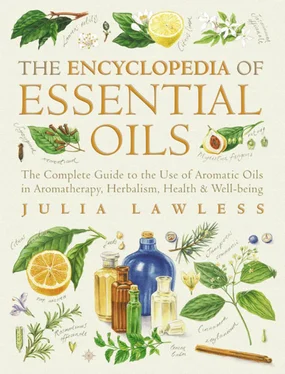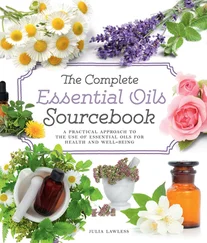OTHER SPECIESThere are many varieties of basil occurring all over the world, used both for their culinary and medicinal applications, such as bush basil (O. minimum) , holy basil (O. sanctum) , both from India, camphor basil (O. kilimanjaricum) from East Africa (also grown in India), and the fever plant (O. viride) from West Africa. However, there are two principal chemotypes most commonly used for the extraction of essential oil: the so-called ‘ French basil’ and the ‘ exotic basil’ – see separate entry.
HERBAL/FOLK TRADITIONWidely used in Far Eastern medicine especially in the Ayurvedic tradition, where it is called tulsi. It is used for respiratory problems such as bronchitis, coughs, colds, asthma, ’flu and emphysema but is also used as an antidote to poisonous insect or snake bites. It has also been used against epidemics and fever, such as malaria. It improves blood circulation and the digestive system and in China it is used for stomach and kidney ailments.
In the West it is considered a ‘cooling’ herb, and is used for rheumatic pain, irritable skin conditions and for those of a nervous disposition. It is a popular culinary herb, especially in Italy and France.
ACTIONSAntidepressant, antiseptic, antispasmodic, carminative, cephalic, digestive, emmenagogue, expectorant, febrifuge, galactagogue, nervine, prophylactic, restorative, stimulant of adrenal cortex, stomachic, tonic.
EXTRACTIONEssential oil by steam distillation from the flowering herb.
CHARACTERISTICS‘True’ sweet basil oil is a colourless or pale yellow liquid with a light, fresh sweet-spicy scent and balsamic undertone. It blends well with bergamot, clary sage, lime, opopanax, oakmoss, citronella, geranium, hyssop and other ‘green’ notes.
PRINCIPAL CONSTITUENTSLinalol (40–45 per cent), methyl chavicol (23.8 per cent) and small amounts of eugenol, limonene and citronellol, among others.
SAFETY DATARelatively non-toxic, non-irritant, possible sensitization in some individuals. Avoid during pregnancy.
AROMATHERAPY/HOME USE
Skin Care : Insect bites (mosquito, wasp), insect repellent.
Circulation, Muscles and Joints : Gout, muscular aches and pains, rheumatism.
Respiratory Syste : Bronchitis, coughs, earache, sinusitis.
Digestive System : Dyspepsia, flatulence, nausea.
Genito-Urinary System : Cramps, scanty periods.
Immune System : Colds, fever, ’flu, infectious disease.
Nervous System : Anxiety, depression, fatigue, insomnia, migraine, nervous tension: ‘Oil of Basil is an excellent, indeed perhaps the best, aromatic nerve tonic. It clears the head, relieves intellectual fatigue, and gives the mind strength and clarity.’ 8
OTHER USESThe oil is used in soaps, cosmetics and perfumery; it is also used extensively in major food categories, especially savouries.
Pimenta racemosa
FAMILYMyrtaceae
SYNONYMS Myrcia acris, Pimenta acris , myrcia, bay, bay rum tree, wild cinnamon, bayberry, bay leaf (oil).
GENERAL DESCRIPTIONA wild-growing tropical evergreen tree up to 8 metres high, with large leathery leaves and aromatic fruits.
DISTRIBUTIONNative to the West Indies, particularly Dominica where the essential oil is produced.
OTHER SPECIESThere are several other varieties, for example the anise-scented and lemon-scented bay, the oils of which have a totally different chemical composition. Not to be confused with bay laurel, the common household spice, nor with the North American bayberry or wax myrtle (Myrcia cerifera) well known for its wax yielding berries.
HERBAL/FOLK TRADITIONThe West Indian bay tree is often grown in groves together with the allspice or pimento bush, then the fruits of both are dried and powdered for the preparation of the household allspice. The so-called bay rum tree also provides the basic ingredient for the famous old hair tonic, which is made from the leaves by being distilled in rum. ‘A hair application with both fragrant and tonic virtues … useful for those who suffer from greasy hair and need a spirit-based, scalp-stimulating lotion to help them to control their locks!’ 9
ACTIONSAnalgesic, anticonvulsant, antineuralgic, antirheumatic, antiseptic, astringent, expectorant, stimulant, tonic (for hair).
EXTRACTIONEssential oil by water or steam distillation from the leaves. An oleoresin is also produced in small quantities.
CHARACTERISTICSA dark yellow mobile liquid with a fresh-spicy top note and a sweet-balsamic undertone. It blends well with lavander, lavandin, rosemary, geranium, ylang ylang, citrus and spice oils.
PRINCIPAL CONSTITUENTSEugenol (up to 56 per cent), myrcene, chavicol and, in lesser amounts, methyl eugenol, linalol, limonene, among others.
SAFETY DATAModerately toxic due to high eugenol content; also a mucous membrane irritant – use in moderation only. Unlike bay laurel, however, it does not appear to cause dermal irritation or sensitization.
AROMATHERAPY/HOME USE
Skin Care : Scalp stimulant, hair rinse for dandruff, greasy, lifeless hair, and premoting growth.
Circulation, Muscles And Joints : Muscular and articular aches and pains, neuralgia, poor circulation, rheumatism, sprains, strains.
IMMUNE SYSTEM:Colds, ’flu, infectious diseases.
OTHER USESExtensively used in fragrance work, in soaps, detergents, perfumes, aftershaves and hair lotions, including bay rum. Employed as a flavour ingredient in many major food categories, especially condiments, as well as alcoholic and soft drinks.
Styrax benzoin
FAMILYStyracaceae
SYNONYMSGum benzoin, gum benjamin, styrax benzoin.
GENERAL DESCRIPTIONA large tropical tree up to 20 metres high with pale green citrus-like leaves, whitish underneath, bearing hard-shelled flattish fruit about the size of a nutmeg. The benzoin is a pathological product, formed when the trunk is cut; the tree exudes a balsamic resin which hardens upon exposure, to air and sunlight.
DISTRIBUTIONNative to tropical Asia; the two main regions of production are Sumatra, Java and Malaysia for ‘Sumatra’ benzoin, and Laos, Vietnam, Cambodia, China and Thailand for ‘Siam’ benzoin.
OTHER SPECIESThere are many different varieties within the Styrax family which produce benzoin, but these are generally classified under either Sumatra benzoin (S. paralleloneurus) or Siam benzoin (S. tonkinensis) – see also Botanical Classificationsection.
HERBAL/FOLK TRADITIONIt has been used for thousands of years in the east as a medicine and incense; the fumigations were believed to drive away evil spirits. It was used by the Chinese herbalists for its heating and drying qualities, as a good urinary antiseptic and as an aid to digestion.
In the west, it is best known in the form of compound tincture of benzoin or Friars Balsam, used for respiratory complaints. Externally it is used for cuts and irritable skin conditions; internally it is used as a carminative for indigestion, etc. It also acts as a preservative of fats.
ACTIONSAnti-inflammatory, anti-oxidant, antiseptic, astringent, carminative, cordial, deodorant, diuretic, expectorant, sedative, styptic, vulnerary.
Читать дальше












